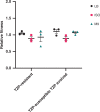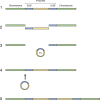Piperacillin/tazobactam resistance in a clinical isolate of Escherichia coli due to IS26-mediated amplification of blaTEM-1B
- PMID: 33004811
- PMCID: PMC7530762
- DOI: 10.1038/s41467-020-18668-2
Piperacillin/tazobactam resistance in a clinical isolate of Escherichia coli due to IS26-mediated amplification of blaTEM-1B
Abstract
A phenotype of Escherichia coli and Klebsiella pneumoniae, resistant to piperacillin/tazobactam (TZP) but susceptible to carbapenems and 3rd generation cephalosporins, has emerged. The resistance mechanism associated with this phenotype has been identified as hyperproduction of the β-lactamase TEM. However, the mechanism of hyperproduction due to gene amplification is not well understood. Here, we report a mechanism of gene amplification due to a translocatable unit (TU) excising from an IS26-flanked pseudo-compound transposon, PTn6762, which harbours blaTEM-1B. The TU re-inserts into the chromosome adjacent to IS26 and forms a tandem array of TUs, which increases the copy number of blaTEM-1B, leading to TEM-1B hyperproduction and TZP resistance. Despite a significant increase in blaTEM-1B copy number, the TZP-resistant isolate does not incur a fitness cost compared to the TZP-susceptible ancestor. This mechanism of amplification of blaTEM-1B is an important consideration when using genomic data to predict susceptibility to TZP.
Conflict of interest statement
The authors declare no competing interests.
Figures





Similar articles
-
IS26 and the IS26 family: versatile resistance gene movers and genome reorganizers.Microbiol Mol Biol Rev. 2024 Jun 27;88(2):e0011922. doi: 10.1128/mmbr.00119-22. Epub 2024 Mar 4. Microbiol Mol Biol Rev. 2024. PMID: 38436262 Free PMC article. Review.
-
A high-resolution genomic and phenotypic analysis of resistance evolution of an Escherichia coli strain from a critically unwell patient treated with piperacillin/tazobactam.J Med Microbiol. 2025 May;74(5):002018. doi: 10.1099/jmm.0.002018. J Med Microbiol. 2025. PMID: 40388325 Free PMC article.
-
Resistance to piperacillin/tazobactam in Escherichia coli resulting from extensive IS26-associated gene amplification of blaTEM-1.J Antimicrob Chemother. 2019 Nov 1;74(11):3179-3183. doi: 10.1093/jac/dkz349. J Antimicrob Chemother. 2019. PMID: 31411684
-
Extensive Gene Amplification as a Mechanism for Piperacillin-Tazobactam Resistance in Escherichia coli.mBio. 2018 Apr 24;9(2):e00583-18. doi: 10.1128/mBio.00583-18. mBio. 2018. PMID: 29691340 Free PMC article.
-
Contribution of β-lactamase and efflux pump overproduction to tazobactam-piperacillin resistance in clinical isolates of Escherichia coli.Int J Antimicrob Agents. 2020 Apr;55(4):105919. doi: 10.1016/j.ijantimicag.2020.105919. Epub 2020 Feb 13. Int J Antimicrob Agents. 2020. PMID: 32062000
Cited by
-
IS26 and the IS26 family: versatile resistance gene movers and genome reorganizers.Microbiol Mol Biol Rev. 2024 Jun 27;88(2):e0011922. doi: 10.1128/mmbr.00119-22. Epub 2024 Mar 4. Microbiol Mol Biol Rev. 2024. PMID: 38436262 Free PMC article. Review.
-
Intracellular Transposition of Mobile Genetic Elements Associated with the Colistin Resistance Gene mcr-1.Microbiol Spectr. 2023 Feb 14;11(1):e0327822. doi: 10.1128/spectrum.03278-22. Epub 2022 Dec 13. Microbiol Spectr. 2023. PMID: 36511714 Free PMC article.
-
Genome sequencing unveils blaKPC-2-harboring plasmids as drivers of enhanced resistance and virulence in nosocomial Klebsiella pneumoniae.mSystems. 2024 Feb 20;9(2):e0092423. doi: 10.1128/msystems.00924-23. Epub 2024 Jan 9. mSystems. 2024. PMID: 38193706 Free PMC article.
-
IS26 Veers Genomic Plasticity and Genetic Rearrangement toward Carbapenem Hyperresistance under Sublethal Antibiotics.mBio. 2021 Feb 22;13(1):e0334021. doi: 10.1128/mbio.03340-21. Epub 2022 Feb 8. mBio. 2021. PMID: 35130728 Free PMC article.
-
Epidemiological Analysis of Extended-Spectrum β-Lactamase-Producing Klebsiella pneumoniae Outbreak in a Neonatal Clinic in Poland.Antibiotics (Basel). 2022 Dec 28;12(1):50. doi: 10.3390/antibiotics12010050. Antibiotics (Basel). 2022. PMID: 36671251 Free PMC article.
References
Publication types
MeSH terms
Substances
Grants and funding
LinkOut - more resources
Full Text Sources
Medical

